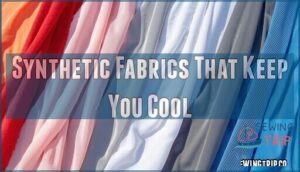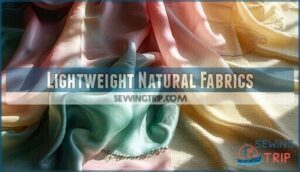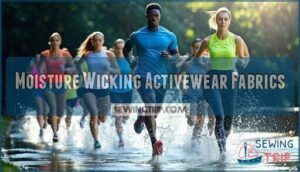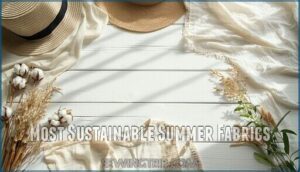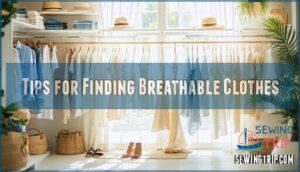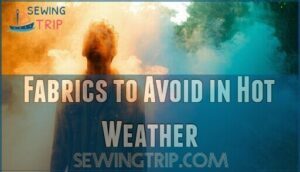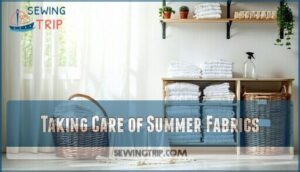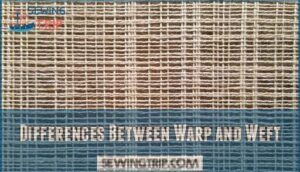This site is supported by our readers. We may earn a commission, at no cost to you, if you purchase through links.
 When sweat clings to your skin and your clothes feel like a damp blanket, the fabric you’re wearing matters more than the temperature outside. That sticky, uncomfortable feeling isn’t just about heat—it’s about how well your clothing lets air circulate and moisture escape. The right fabric can transform a sweltering day into something bearable, while the wrong choice leaves you counting down the minutes until you can change.
When sweat clings to your skin and your clothes feel like a damp blanket, the fabric you’re wearing matters more than the temperature outside. That sticky, uncomfortable feeling isn’t just about heat—it’s about how well your clothing lets air circulate and moisture escape. The right fabric can transform a sweltering day into something bearable, while the wrong choice leaves you counting down the minutes until you can change.
Cotton, linen, and moisture-wicking synthetics each react to heat differently, and knowing which breathable fabrics work best for your lifestyle can make summer feel less like an endurance test. Whether you’re choosing activewear for your morning run or a breezy outfit for weekend plans, understanding your options helps you stay cool when the mercury climbs.
Table Of Contents
- Key Takeaways
- Best Fabrics for Hot Weather
- Synthetic Fabrics That Keep You Cool
- Lightweight Natural Fabrics
- Denim and Chambray for Summer
- Moisture Wicking Activewear Fabrics
- Most Sustainable Summer Fabrics
- Tips for Finding Breathable Clothes
- Fabrics to Avoid in Hot Weather
- Taking Care of Summer Fabrics
- Differences Between Warp and Weft
- Frequently Asked Questions (FAQs)
- Conclusion
Key Takeaways
- Natural fibers like cotton and linen deliver excellent breathability by allowing air circulation and moisture escape, while synthetic options like polyester and nylon excel at wicking sweat away from your skin during active pursuits.
- Fabric weight and weave structure matter more than material alone—looser weaves in lightweight fabrics under 10 ounces provide better airflow, while tight weaves trap heat regardless of fiber type.
- Sustainable summer fabrics including organic cotton, linen, bamboo, and Tencel offer eco-friendly breathability through minimal water usage and responsible production methods that don’t sacrifice comfort.
- Avoid heavy, tightly woven materials like conventional denim, wool, velvet, and dense polyester blends in hot weather since they trap heat and prevent sweat evaporation, leaving you uncomfortable throughout the day.
Best Fabrics for Hot Weather
When temperatures climb, what you wear makes a real difference. Some fabrics almost seem to breathe with you, letting heat and sweat escape.
Here’s what to look for when you want to stay cool out there.
Cotton
When the temperatures climb and sweat is a given, cotton steps in like an old friend—light, easy, and ready to help you breathe easy. Cotton’s natural fibers mean you get maximum airflow, gentle moisture absorption, and a soft touch against your skin. Whether you’re grabbing organic cotton tees or exploring cotton blends, this fabric is truly the hero of breathable summer fabrics and comfortable, durable summer clothing.
- Breathable cotton weaves let heat escape
- Organic cotton encourages sustainable sourcing
- Cotton absorbs moisture without clinging
- Cotton blends add strength and flexibility
- Durable cotton stands up to endless summer washes
Linen
If cotton’s your go-to for staying cool, think of linen as its breezy cousin—always ready to manage heatwaves with barely a sweat. Linen’s natural fibers form loose weaves that let air dance through, whisking away moisture fast.
This isn’t just tradition; linen history proves its worth in every sticky summer. Linen blends ramp up softness and strength, while careful linen sourcing guarantees you stay comfy, dry, and eco-friendly. Durability means your favorite summer fabrics last.
Rayon
Linen’s got the history, but if you like your summer shirts silky smooth and breezy, rayon steps up with comfort that feels just as easygoing. Here’s why rayon is a standout among breathable fabrics for hot weather:
- Rayon production starts with plant cellulose, making it semi-synthetic.
- Lightweight weave offers impressive airflow.
- Great for drapey summer outfits.
- Rayon wrinkles easily, so try rayon blends for better durability.
Synthetic Fabrics That Keep You Cool
Natural fibers aren’t the only way to beat the heat. Some synthetic materials are designed to keep you just as cool and comfortable.
Here are a few top picks to keep in mind.
Polyester
Ever wonder why your favorite workout shirt never clings or feels soaked after a sweaty run? That’s polyester working its magic. This synthetic fabric pulls sweat away from your skin fast, keeping you dry even when you’re pushing hard.
Sure, it’s not the most breathable option out there, but polyester blends—especially those mixed with merino wool—balance comfort with performance.
Recycled polyester and microfiber polyester options give you eco-friendly choices. Its durability means your gear lasts through countless workouts, making it a smart pick for moisture-wicking performance fabrics in hot weather.
Nylon
Lightweight and quick-drying, nylon lets your skin breathe while wicking moisture away so you stay fresh during a long summer day. You’ll find it in everything from hiking shorts to casual tees. Nylon blends often mix with cotton or spandex for added stretch and softness.
While it’s durable and resists wrinkles, nylon can hold onto odors—consider breathable fabric options like linen or moisture-wicking polyester blends as nylon alternatives for summer clothing.
Lightweight Natural Fabrics
Not all natural fabrics are created equal for coping with the heat. While cotton and linen are summer staples, there are two other natural materials worth considering that might surprise you.
Let’s look at silk and wool—both offer unique benefits for staying comfortable when temperatures climb.
Silk
You mightn’t think of silk as summer-ready, but this smooth fabric actually breathes beautifully and adjusts to your body temperature like a second skin. Thanks to silk production methods that preserve natural fibers, this lightweight material wicks moisture while staying soft against your skin.
Whether you choose mulberry or tussah silk types, you’ll enjoy the breathable fabric properties that make it ideal for summer clothing recommendations. While silk alternatives exist, nothing quite matches silk’s unique benefits—it’s a natural fiber that keeps you cool without sacrificing style.
Wool
When the mercury climbs, merino wool becomes your secret weapon—this natural fiber breathes, wicks moisture, and actually regulates your body temperature better than most summer fabrics you’d expect. Lightweight merino wool offers breathable fabric properties that make it surprisingly comfortable in heat, while wool blends give you similar breathability with added durability.
When temperatures soar, lightweight merino wool breathes, wicks sweat, and regulates body heat better than you’d expect from a fiber often associated with winter
If you’re exploring wool alternatives, know that proper wool care and responsible wool sourcing guarantee this fabric stays soft and functional season after season.
Denim and Chambray for Summer
Denim might seem like an odd pick for summer, but its lighter cousin—chambray—can actually hold its own when the heat rolls in. Traditional denim weight can feel heavy and trap heat, but chambray offers better breathability thanks to its looser weave. The key difference? Chambray uses a plain weave with colored warp threads and white weft threads, creating a softer, more lightweight fabric than standard denim.
For summer styling, look for breathable denim alternatives in lighter weights—usually under 10 ounces. You’ll stay cooler without sacrificing that classic denim look you love. Chambray shirts and dresses work beautifully for casual summer outings, giving you durability without the sweat.
The trick is choosing the right weight and fit. Opt for relaxed cuts that allow airflow rather than tight, restrictive styles. Both fabrics offer colorfastness and long-lasting wear, so they’re practical investments for your warm-weather wardrobe.
Moisture Wicking Activewear Fabrics
Activewear built with moisture-wicking fabrics turns your toughest workouts into manageable sessions by pulling sweat away from your skin before it pools. These performance blends use sophisticated fibers engineered to move moisture to the fabric’s outer surface, where it evaporates fast—keeping you dry and focused.
The global moisture-wicking fabrics market is projected to hit $3.86 billion by 2029, driven by innovations like CAVA Athleisure’s ADPT fabric launched in January 2025. The Asia-Pacific region is expected to be the largest market globally, demonstrating significant growth in demand. Modern materials even incorporate silver for odor control, reducing bacterial build-up during intense training.
Top moisture-wicking materials include:
- Polyester: First-rate fabric performance with rapid sweat evaporation and better breathability
- Nylon: Lightweight construction offers quick-drying properties and extended freshness
- Modal blends: Demonstrate 50% faster wicking speed compared to conventional fibers
When shopping for moisture-wicking activewear, check labels for these synthetic options or modal-cotton blends. They’ll outperform traditional cotton every time, giving you comfort that lasts from warm-up to cool-down.
Most Sustainable Summer Fabrics
Choosing sustainable summer fabrics means you’re keeping your closet cool while protecting the planet—think of it as fashion with a conscience. Organic cotton grows without harsh pesticides, reducing water usage and environmental impact compared to conventional cotton. Linen stands out as one of the most eco-friendly fabrics since it needs minimal water and thrives without heavy chemical treatments. Bamboo fabric offers renewable softness that’s naturally antibacterial, while Tencel (lyocell) transforms fast-growing eucalyptus trees into breathable material using a closed-loop process that recycles nearly all chemicals. Hemp requires few pesticides and produces durable, breathable textiles perfect for hot weather.
These sustainable fabrics deliver excellent breathability, feel smooth against your skin, and represent ethical sourcing practices. You’re supporting fabric lifecycles that prioritize biodegradability and responsible weaving methods—staying comfortable while reducing waste. Hemp, for example, boasts natural breathability and moisture-wicking abilities.
Tips for Finding Breathable Clothes
Finding the right breathable clothes isn’t just about grabbing any lightweight piece off the rack—it’s about knowing what to look for so you don’t end up sweating through your day. Here’s how to build a summer wardrobe that actually keeps you cool:
- Check the weave density—look for looser, porous fabrics like linen or cotton that let air circulate.
- Choose light colors—they reflect heat instead of soaking it up like darker shades do.
- Prioritize loose fit and airflow—relaxed silhouettes beat skin-tight styles every time.
- Read fabric labels—natural fibers or moisture-wicking synthetics work best for hot weather clothing.
Smart layering strategies and breathable fabric options make all the difference when temperatures climb.
Fabrics to Avoid in Hot Weather
Not all fabrics are created equal when it comes to beating the heat. Some materials actually work against you, trapping warmth and moisture when you need relief most. Polyester retains barely any moisture—just 0.4%—which means sweat sits on your skin instead of evaporating. That polyester discomfort comes from tightly woven fibers that block airflow and lock heat against your body. Nylon impermeability creates similar problems, absorbing less than 4% of its weight in water.
Even natural fibers can betray you: conventional wool insulation makes it absorb up to 30% of its weight in moisture before feeling wet, delaying the cooling you desperately need. Denim weight—often 10 to 14 ounces per yard—doubles typical summer cottons, reducing evaporative cooling. Satin retention and velvet’s dense weaves trap heat like a blanket. These heat-trapping fabrics guarantee sweat marks and discomfort.
| Fabric | Why It Traps Heat |
|---|---|
| Polyester | Blocks airflow, retains odor |
| Nylon | Impermeable, holds sweat |
| Wool | High insulation, slow drying |
| Denim | Heavyweight, tight weave |
Choose lighter alternatives like cotton or linen to escape these synthetic fabric pitfalls.
Taking Care of Summer Fabrics
Your favorite summer clothes deserve better than a random toss in the washing machine—especially if you want them to last more than one season. Proper linen care and summer fabric care start with understanding what each material needs. Delicate fabrics like silk and rayon respond best to cool water and gentle detergent—harsh chemicals strip natural fibers of their breathability.
For drying methods, skip the dryer heat trap. Air drying on a rack or line prevents shrinkage and maintains the drape that makes summer wardrobe staples feel so good. For stain removal, tackle spills immediately with cold water before they set. Storage solutions matter too: fold breathable pieces in cotton bins rather than plastic containers that trap moisture and invite mildew. Taking care of summer fabrics doesn’t require much effort, just consistency.
Quick fabric care wins:
- Wash cottons and linens in cold water with mild detergent
- Air dry lightweight pieces flat to prevent stretching
- Store folded items in breathable containers away from direct sunlight
Differences Between Warp and Weft
Ever wonder why some fabrics hold their shape better than others—or why that linen shirt stretches out in weird directions after a few washes? The answer lies in warp and weft—the two sets of yarns that create fabric structure. Warp yarns run lengthwise under tension during weaving, giving them enhanced warp strength and fabric stability. Weft yarns weave horizontally across, providing weft elasticity and influencing drape.
Here’s what makes them different:
- Warp yarns are stretched tight on the loom, creating a sturdy backbone that resists stretching and maintains shape over time.
- Weft yarns interlace through warp threads, determining weave patterns and how the fabric moves with your body.
- Weave tightness affects breathability—looser weft spacing means better airflow for summer comfort.
Understanding these warp and weft differences helps you choose fabrics that’ll keep their cool factor season after season. Drape influence comes from this hidden architecture working together.
Frequently Asked Questions (FAQs)
What are some tips for finding breathable clothes for summer?
When shopping for hot weather clothing, start with loose-fitting styles that allow airflow next to your skin.
Look for lightweight fabric with a porous weave—cotton, linen, or rayon work well.
Choose light colors over dark ones since they absorb less heat.
How do fabric blends compare to pure materials?
Think of blends as a handshake between two worlds. Fabric blends merge natural and synthetic fabrics to balance breathability with durability.
Pure materials offer authentic texture differences, while blended fabrics reduce care complexity and cost. Comparison favors performance variation over single-fiber limitations.
What thread count works best for hot climates?
Thread count myths suggest higher is always better, but that’s not true for hot weather.
For breathable fabrics and summer clothing, ideal ranges sit between 200-400—lower counts in lightweight fabric like percale improve airflow better than dense sateen weaves, since fiber type matters more than numbers alone.
Can darker breathable fabrics still keep you cool?
Darkness vs. breathability—they’re not opposites. Dark colors absorb more heat, but breathable fabrics like lightweight linen or moisture-wicking polyester can still keep you cool through airflow and quick evaporation, especially in looser weaves.
Do loosely woven fabrics last as long?
Not necessarily. Loose weave longevity depends more on fiber quality and care impact than weave tightness alone.
Linen’s loose weave construction matters less when the fiber properties are strong, making it surprisingly durable with proper care.
Which fabrics dry fastest after getting wet?
When you get caught in a sudden summer rain, drying time matters. Synthetic fabrics like polyester and nylon win the quick-drying race thanks to low absorbency rates and tight weave structures.
Natural fabrics like cotton hold moisture longer due to higher fabric absorbency, while humidity affects all drying times regardless of fabric properties.
Conclusion
It’s no coincidence that the coolest people you know seem unbothered by summer heat—they’ve figured out what you’re learning now. Your comfort depends on choosing breathable fabrics for hot weather that match how you move, sweat, and live.
Cotton works for laid-back days, linen breathes like nothing else, and moisture-wicking synthetics manage intense activity without complaint.
The fabric you wear shapes your entire summer experience, so pick wisely and stop letting the heat win.
- https://en.wikipedia.org/wiki/Textile
- https://www.britannica.com/science/summer-season
- https://www.researchandmarkets.com/reports/6089849/moisture-wicking-fabrics-market-report
- https://www.transparencymarketresearch.com/moisture-wicking-fabrics-market.html
- https://www.futuremarketinsights.com/reports/sweat-resistant-apparel-market




